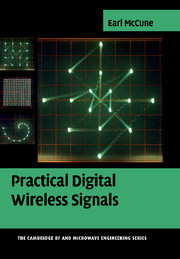Book contents
- Frontmatter
- Contents
- Preface
- Definitions and acronyms
- Terminology and notation
- 1 Keying, states, and block diagram construction
- 2 Common issues and signal characterization
- 3 Important details on results from Shannon, Nyquist, and others
- 4 Digital amplitude modulation (ASK)
- 5 Digital frequency modulation: FSK
- 6 Digital phase modulation: PSK
- 7 Combined digital modulations: QAM and OFDM
- 8 Spread spectrum
- 9 Wireless propagation and antenna fundamentals
- 10 Principles of coding
- 11 Multiple access techniques
- 12 Signal tradeoffs and system evolution
- Tutorial Appendices
- Index
- References
1 - Keying, states, and block diagram construction
Published online by Cambridge University Press: 04 August 2010
- Frontmatter
- Contents
- Preface
- Definitions and acronyms
- Terminology and notation
- 1 Keying, states, and block diagram construction
- 2 Common issues and signal characterization
- 3 Important details on results from Shannon, Nyquist, and others
- 4 Digital amplitude modulation (ASK)
- 5 Digital frequency modulation: FSK
- 6 Digital phase modulation: PSK
- 7 Combined digital modulations: QAM and OFDM
- 8 Spread spectrum
- 9 Wireless propagation and antenna fundamentals
- 10 Principles of coding
- 11 Multiple access techniques
- 12 Signal tradeoffs and system evolution
- Tutorial Appendices
- Index
- References
Summary
Just to be absolutely clear – even though this book is about digital wireless communication (DWC) signals, the wireless signal itself is analog. All wireless signals, and actually all signals whether wireless or not, are single, real, continuous-time analog waveforms.
The characteristic which makes us consider them as digital signals is that the information in the signal is only available at particular times, which are separate from one another and distinct. As far as the information is concerned, what the signal does in between these time instances is of no concern. But – and this is an extremely important BUT – the usefulness of the signal in actual transmission is extremely sensitive to the detail of the signal behavior at all times, particularly the time intervals between the information points. Indeed, much of this book is concerned with the fine details of what the DWC signal of choice is doing at all times.
So let us begin by examining what makes us consider that these signals are digital. No matter if signal phase, frequency, amplitude, or some combination is used for modulation, all digital wireless communication signals are a sequence of states. This simply means that the information in the digital wireless communication signal can only be represented by a (usually short) finite list of particular and very specific signal characteristics. Outside of this very restricted set of signal characteristics, the information content of the signal is undefined.
- Type
- Chapter
- Information
- Practical Digital Wireless Signals , pp. 1 - 22Publisher: Cambridge University PressPrint publication year: 2010



